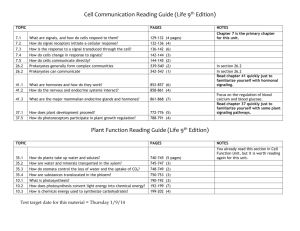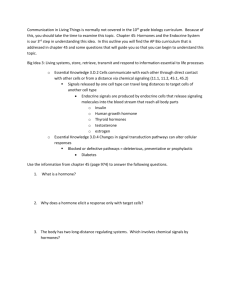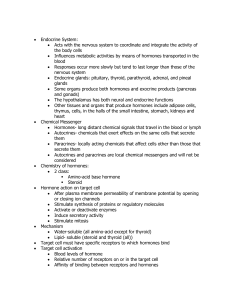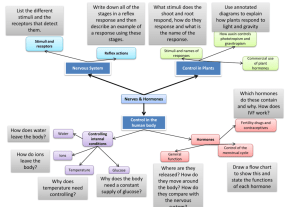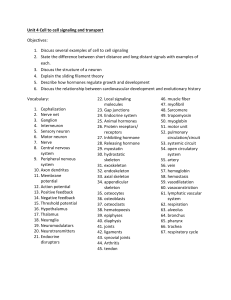Hormones and Response Pathways
advertisement
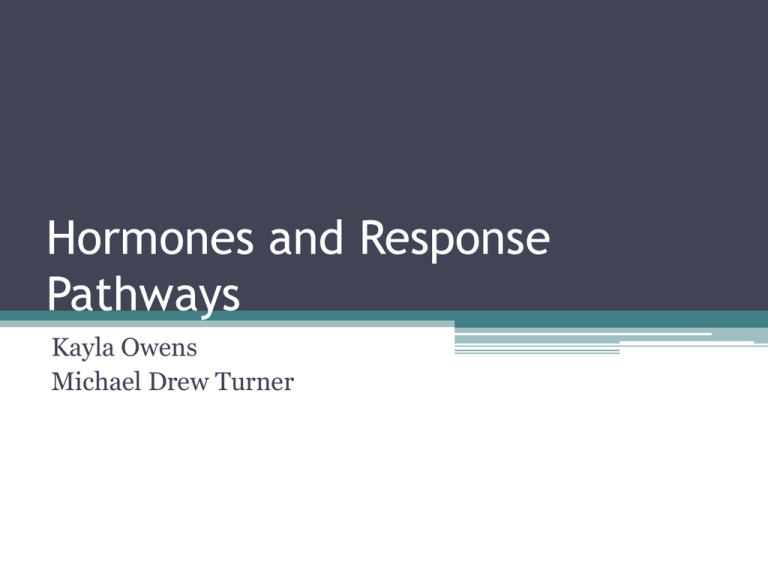
Hormones and Response Pathways Kayla Owens Michael Drew Turner Types of Secreted Signaling Molecules • Hormones, local regulators, neurotransmitters, pheromones, and neurohormones • Trigger responses by binding to specific receptor proteins in or on the target cells • Only target cells have receptors for these secreted signaling molecules, other types of cells are unresponsive to that type of molecule Hormones and Endocrine Signaling • Endocrine glands—a group of endocrine cells in a ductless organ • Hormones are secreted through the blood stream ▫ Maintain homeostasis, mediate responses to environmental stimuli; regulate growth, development, and reproduction ▫ Used in endocrine signaling Local Regulators • Local regulators—secreted molecules that act over short distances and reach their target cells by diffusion ▫ Play roles in many processes such as blood pressure regulation, nervous system function, and reproduction ▫ Function in paracrine and autocrine signaling • Paracrine and autocrine signaling ▫ Paracrine—target cells lie near the secreting cell ▫ Autocrine—secreted molecules act on the secreting molecule itself Neurotransmitters and Synaptic Signaling • Neurotransmitters—neurons secrete these that diffuse a very short distance to bind receptors on the target cells ▫ These are very important for sensation, memory, cognition, and movement Neuroendocrine Signaling and Neurohormones • Use neurosecretory cells that are specialized neurons typically found in the brain; they then secrete molecules that diffuse from nerve call endings into the blood stream • Neurohormones—travel through bloodstream to reach target cells, a special class of hormone Chemical Classes of Hormones • Hormones are often divided into three groups ▫ ▫ ▫ ▫ Polypeptides—ex. Insulin—water soluble Amines—ex. Epinephrine—water soluble Steroids—ex. Cortisol—lipid soluble *differ in form and solubility Cellular Response Pathways • Water soluble hormones travel through the bloodstream and bind to cell-surface receptors • This triggers a cytoplasmic response or change in gene expression • Lipid soluble hormones travel through the bloodstream and are bound to transport proteins • Enter target cells and bind to a receptor in the cytoplasm or nucleus • Binding of water soluble hormones initiates signal transduction— converts extracellular signals to specific intracellular responses ▫ Epinephrine (adrenaline)—released in response to stress by the adrenal gland, results in release of glucose into bloodstream ▫ Steroid hormones—bind to cytoplasmic receptors; this complex moves to the nucleus and stimulates transcription of specific genes; ex. Thyroxin, vitamin D, testosterone, etc. Multiple Effects of Hormones • A given signal can have different effects on different target cells and can produce different effects in different species • Differences may result from ▫ Types of receptors ▫ Specific signal transduction pathways present ▫ Particular transcription factors that are activated Signaling by Local Regulators • Cytokines—polypeptide regulators involved in immune responses • Growth factors—polypeptides that are required in the extracellular environment for many types of cells to divide and develop • Nitric oxide—a gas that can serve as a neurotransmitter and as a local regulator that produces vasodilation, increasing blood flow • Prostaglandins—modified fatty acids that have a wide range of effects on nearby target cells; help to induce labor ▫ Aspirin and ibuprofen inhibit the synthesis of prostaglandins and thus reduce their fever and inflammation inducing and pain intensifying actions
